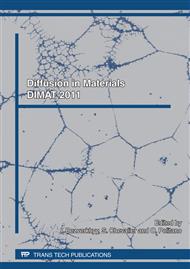p.477
p.485
p.491
p.497
p.503
p.509
p.517
p.523
p.529
The Solubility of Indium in Liquid Gallium Supercooled to 12 K
Abstract:
The method of perturbed angular correlation (PAC) was used to determine lattice locations of 111In impurity probe atoms present in extreme dilution in the intermetallic compound FeGa3. In slightly Ga-poor samples, probes were found to strongly prefer one of two inequivalent Ga-sites. In slightly Ga-rich samples at room temperature, 293 K, the PAC spectrum exhibited an unperturbed quadrupole interaction signal that is consistent with indium probes dissolved in small liquid pools of the excess Ga. A myriad of such pools are probably located along grain boundaries in the sample. Cooling from 293 K down to 12 K, the site fraction of indium in liquid decreased, being offset by the increase in a signal attributed to indium solutes in precipitates with other impurities at the sides of the Ga pools. However, these changes were completely reversible upon heating, and no crystallization of the liquid gallium pools was observed down to 12 K. This is attributed to the extraordinarily small volumes for the pools, which, while not measured directly, are orders of magnitude smaller than cubic microns. The measured temperature dependence of the site fraction of indium in the liquid was used to extend the metastable solubility curve for indium in liquid gallium down to a temperature of 150 K, much lower than the eutectic temperature of Ga-In at 288.5 K.
Info:
Periodical:
Pages:
503-508
Citation:
Online since:
April 2012
Authors:
Price:
Сopyright:
© 2012 Trans Tech Publications Ltd. All Rights Reserved
Share:
Citation:


